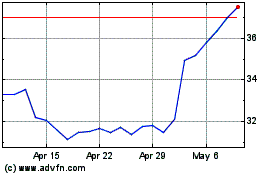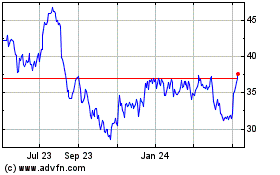The possible merger between DuPont Co. and Dow Chemical Co.
would create a chemical-industry colossus spanning industrial
materials and agriculture, prompting what would likely be a
detailed and lengthy review by government antitrust enforcers.
Combining the two U.S. industrial icons, which would create a
company with a market value of more than $130 billion based on
Wednesday's share prices, would likely draw complaints from some
farmers and other customers wary of market concentration.
Adding to the uncertainty, the merger talks come as U.S.
enforcers have blocked several high-profile deals.
Still, a deal could well meet regulatory muster, some analysts
said, because Dow and DuPont don't directly compete in many of
their biggest products and could divest assets in areas where they
do overlap, like corn seeds and housewrap.
"For the last 10 years, the companies have not truly been
competitors," said Jonas Oxgaard, an analyst with Sanford C.
Bernstein. Dow and DuPont "used to be the two big rivals in
American chemicals, but they've gone down completely divergent
paths."
Dow, based in Midland, Mich., and DuPont, based in Wilmington,
Del., are discussing a merger of equals that would lead to a
three-way split of the combined businesses into new companies
centered on agriculture, plastics and other chemical-based
materials, and specialty products like enzymes, The Wall Street
Journal reported Tuesday.
According to people familiar with the talks, the parties have
spent little time on antitrust because their lawyers believe there
is little concern thanks to the pending three-way split, which is
intended to ease pushback. The companies plan to bill the combined
company as only a temporary vehicle to cut costs before splitting,
and believe there is minimal antitrust overlap across those
businesses.
Seth Bloom, a Washington-based antitrust lawyer not involved in
the talks, said that combining two large firms isn't necessarily
bad from an antitrust perspective. But he also said it won't
necessarily help Dow and DuPont that they want to break a combined
firm into three new businesses. "What will matter is what kind of
position those businesses have in the marketplace," he said.
Dave Andrea, senior vice president and chief economist for the
Original Equipment Suppliers Association, an automotive suppliers
group, said any combination between major suppliers would prompt
customers to evaluate sourcing.
Wendel Lutz, who farms about 500 acres near Dewey, Ill., said he
worries that further consolidation among farm suppliers could lead
to higher prices at a time when farmers are struggling with three
years of diminished crop prices. "Whenever you have a lack of
competition, it's not going to be a good deal for the purchasers of
those products," he said.
The talks are taking place as both companies have grappled with
collapsing commodity prices that have pressured key customers, and
a strengthening U.S. dollar that has made Dow and DuPont's products
more expensive overseas. The companies are targeting about $3
billion in cost cuts, according to people familiar with the
discussions.
In plastics, both Dow and DuPont develop ethylene-based
products, but target different portions of the market, according to
William Young, managing director at ChemSpeak LLC, a chemical- and
agricultural-industry consultancy. To vehicle makers, Dow sells
adhesives while DuPont sells under-the-hood components, analysts
said. By combining the two, "you get a more full-service supplier,"
Mr. Young said.
Adding DuPont's relatively modest U.S. ethylene-processing
capacity to Dow's would raise the combined entity's annual capacity
to 10.3 billion pounds a year from Dow's current 9 billion, and
represent about 15% of the national total, Mr. Young said.
Sealed Air Corp., which produces plastic wrap and plastic
packaging for the food industry, is a large-volume buyer of resins
from Dow, but has scaled back its business with DuPont. A spokesman
for the North Carolina-based company said a merger "probably
wouldn't have a huge impact on us. DuPont's interest in this
business has been waning, but there are a lot of intermediate
[companies] that can give you supply."
In the third sector, specialty chemicals, Dow and DuPont sell
different products to some of the same customers. For solar panels,
Dow sells modular plates, and DuPont sells pastes that help
transmit power. DuPont sells enzymes to food makers, while Dow
produces polymers for hair gels and lotions.
The Justice Department and the Federal Trade Commission, which
review mergers, both have brought notable legal challenges to deals
this year. They also have approved other closely scrutinized
mergers.
Mr. Bloom, the antitrust lawyer, said he would expect a
Dow-DuPont deal to get close scrutiny. "This is not the easiest
time to get a deal through," he said. Regulators are "going to do a
very granular review."
Sometimes the antitrust agencies consider more than just
traditional head-to-head competition between two companies that are
seeking to merge.
For example, some antitrust observers had questioned whether the
Justice Department had much of a basis to object to Comcast Corp.'s
proposed bid for Time Warner Cable Inc., given that the two
companies didn't compete head-to-head in the same geographic
markets.
Despite the lack of geographic overlaps, the department focused
on concerns the deal could cause competitive harm by giving the
merged firm too much power over broadband, TV channel owners and
the future development of the online video marketplace.
Comcast dropped the deal earlier this year in the face of
objections from the Justice Department and the Federal
Communications Commission.
David Benoit, Alison Sider and Bob Tita contributed to this
article.
(END) Dow Jones Newswires
December 09, 2015 20:25 ET (01:25 GMT)
Copyright (c) 2015 Dow Jones & Company, Inc.
Sealed Air (NYSE:SEE)
Historical Stock Chart
From Mar 2024 to Apr 2024

Sealed Air (NYSE:SEE)
Historical Stock Chart
From Apr 2023 to Apr 2024
